Here in the FIT Library, we have many many books on how to make clothing. There are different points of view on techniques, as well as different types of machinery. In our last post, we spent time reviewing books about the serging or merrow machine and covered a few of our favorite how-to-get-started books on sewing. This time we’re going to present to you our take on some of the more advanced sewing techniques, known collectively as “couture”. You probably want to have some sewing experience under your belt before you start working with any of these books.
Unlike “ready-to-wear” or “pret-a-porter” (i.e. ‘ready-to-wear’ in French), couture implies a super-expensive, highly-skilled approach to the construction of a garment which is made to fit a specific person. This includes doing much of the finishing work, like zipper insertion, putting in linings, seam finishes, buttonholes, setting the collar, and any embellishment, using hand-sewing techniques. This attention to detail ensures that each layer of the garment lies where it should, and that the garment’s inside looks as finished as the outside. While couture and “tailoring” overlap, couture more often refers to dressmaking in softer fabrics, and tailoring usually refers to the use of wools with interfacings stitched to create shaping, such as collars and lapels, as well as a particular type of fit.
Most clothing these days is ready-to-wear: made to generalized sizes, either Small-Medium-Large-Extra Large, or 4-6-8-10-12-14-16. If you shop in stores, this is what you are buying.
Cool Couture, by Kenneth D. King
5th Floor Main Stacks TT713 .K54
Kenneth King (Fashion Design: Apparel) is one of the professors who teaches in the Couture Certificate program here at FIT.
As I mentioned above, you will need basic sewing knowledge to make best use of this book. Some of Professor King’s explanations use garment-center jargon, and some techniques require specialized equipment. Thankfully, the book has clear easy-to-follow photographs. “Cool Couture” covers a lot of techniques, including fine finishings for eveningwear fabrics, a wealth of tailored-pocket finishes, and some really creative trim- and embellishment-techniques.
The author promotes funky novelty linings, beading, embellishing with cords, findings, uses for braids, as well as demonstrating complex piping and seam finishes. He goes further by presenting elaborate tassels, multiple-rows of piping, curved pockets, and built-up passementeries. The author says in the cover, “I believe it’s better to spend a bit more time with a project and achieve something very special, rather than try to save time or money by sewing running shorts and T-shirts…My wish is for this book to stimulate your sense of creativity and adventure.” It certainly does ours!
The Dressmaker’s Handbook of Couture Sewing Techniques Lynda Maynard
5th Floor Main Stacks TT713 .M37
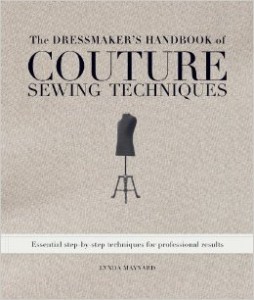 Denise and I are cheering the trend to print hands-on books with spiral bindings, so they will lay flat while in use. This well-written book presents useful techniques in an up-to-date layout with clear photographs and lots of small sidenotes. The author explains how and what her solutions help (e.g. there’s a lot of info on backing fabrics and why use which fabric.) The book includes really beautiful seam, neckline, waist and hem finishes, using ribbons, bias bindings, and organza. While detailed, it misses some techniques that more basic books (e.g. our old favorite, the Reader’s Digest Guide) include, but includes many that aren’t in those. It also includes very detailed descriptions of fabrics used for linings, interlinings, eveningwear and daywear. While this book may be less inspiring than Professor King’s, it’s probably a more thorough workbook for commonly-used finishing techniques.
Denise and I are cheering the trend to print hands-on books with spiral bindings, so they will lay flat while in use. This well-written book presents useful techniques in an up-to-date layout with clear photographs and lots of small sidenotes. The author explains how and what her solutions help (e.g. there’s a lot of info on backing fabrics and why use which fabric.) The book includes really beautiful seam, neckline, waist and hem finishes, using ribbons, bias bindings, and organza. While detailed, it misses some techniques that more basic books (e.g. our old favorite, the Reader’s Digest Guide) include, but includes many that aren’t in those. It also includes very detailed descriptions of fabrics used for linings, interlinings, eveningwear and daywear. While this book may be less inspiring than Professor King’s, it’s probably a more thorough workbook for commonly-used finishing techniques.
Modern Dressmaking Made Easy, by Mary Brooks Picken
5th Floor Main Stacks TT515 .P55 1949
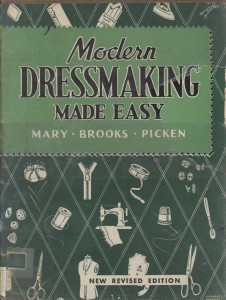 Mary Books Picken (1886-1981) was an early and prolific writer on the subject of fashion and sewing. Some of her accomplishments include publishing 96 books on sewing, fashion, and the textiles arts, teaching the “Economics of Fashion” at Columbia University, founding a school for women, specializing in the domestic arts, in Scranton, Pennsylvania (in 1916), and being one of the founding members of the Metropolitan Museum of Art’s Costume Institute. She was also the first woman to be appointed to the Board of Directors of FIT, in 1951.
Mary Books Picken (1886-1981) was an early and prolific writer on the subject of fashion and sewing. Some of her accomplishments include publishing 96 books on sewing, fashion, and the textiles arts, teaching the “Economics of Fashion” at Columbia University, founding a school for women, specializing in the domestic arts, in Scranton, Pennsylvania (in 1916), and being one of the founding members of the Metropolitan Museum of Art’s Costume Institute. She was also the first woman to be appointed to the Board of Directors of FIT, in 1951.
This book covers all the basic sewing needs: there are illustrated sections on hems, gathers, pleats, godets, decorative hand- and machine-stitches. One section instructs the user about making alterations, and another how to choose flattering lines for all figure types. These sections always reflect the contemporary fashions more than any other, and this book still shows the shoulder pads, bias cuts, and sweetheart necklines of the WWII era. The book even includes some background on color theory and fashion-design concepts.
Picken’s book provides a wealth of info for sewers of all backgrounds, most of it still applicable today. Several sections reflect the era of its publication, however, including the how-to on putting on stockings. Not pantyhose, mind you, stockings.
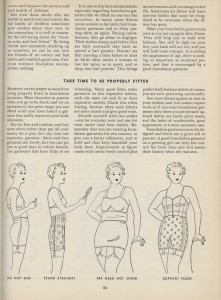 Picken was concerned with the whole self-presentation of her students, and her books reflect this, including not just sewing instruction, but also a section called “First the body, then the clothes” with calisthenics and poise-posture notes.
Picken was concerned with the whole self-presentation of her students, and her books reflect this, including not just sewing instruction, but also a section called “First the body, then the clothes” with calisthenics and poise-posture notes.
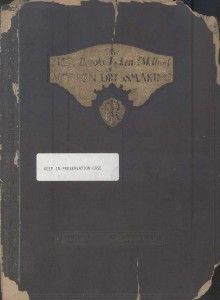
The author setup a school for young ladies in 1916, and this appears to have been a compendium of their course of instruction there. This includes some rather dated information on posture and leg-position-while-seated that will amuse many.
Curiously, an earlier version of this book (1924, shown at left) was illustrated with photographs. While they are black-and-white and their quality is good, in the 40s reprint, the photographs have been replaced by simple line drawings, not unlike those used in Vogue magazine to illustrate new styles.
However, the drawings are pretty clear and the range of techniques demonstrated is impressive. It’s also an insightful peek into what was expected of a young lady, whether entrepreneurially- or house-wifely-minded, in 1949. Rather a treasure, all around.
The Dressmaker’s Technique Bible, by Lorna Knight
5th Floor Main Stacks TT705 .K553
 Here is another spiral-bound book, which we like. And it’s a handy small format, so it’s not difficult to carry it for reference. It provides a solid introduction, with descriptions and photographs of many tools, including machines. Then it proceeds to working with commercial patterns, including a detailed section on how to adjust for common fitting problems. One excellent (and rarely-found) section included here is a style guide, to teach a new sewer what different garment shapes are called.
Here is another spiral-bound book, which we like. And it’s a handy small format, so it’s not difficult to carry it for reference. It provides a solid introduction, with descriptions and photographs of many tools, including machines. Then it proceeds to working with commercial patterns, including a detailed section on how to adjust for common fitting problems. One excellent (and rarely-found) section included here is a style guide, to teach a new sewer what different garment shapes are called.
This is a good basic guide to carry around to teach techniques. It has many of the same basics as the larger format Reader’s Digest or Singer guides, but presented in a smaller format and without the extra projects. Mind you, that means the type is a bit small. Also, some of the finishing techniques I expect in such a book *are* missing here. I would want a bit more detail in a standard reference, but this book includes the short version of most of the simpler things I need to explain when I teach first sewing principles. And that style guide section is quite useful for working with beginners. Denise and I found this to be a solid basic book, especially if one’s eyes are still good.
Dressmaking, the Complete Step-by-Step Guide to Making Your Own Clothes, by Alison Smith
5th Floor Main Stacks TT515 .S645
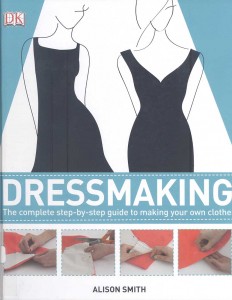 This book has beautifully-clear photographic layouts which include arrows and details drawn on top of them for clarity’s sake. It begins with a layout of sewing tools, including a computerized sewing machine and a serger. The sections on taking measurements and reading pattern-packages correctly are well laid out and easy to follow. It includes detailed instructions on making alterations once one has chosen said pattern. This book is much more a basic sewing manual (say, AP 143) than others reviewed here. It also includes some great instructions for mending ripped garments and customizing patterns with simple embellishments. It includes twelve simple patterns and then walks the reader through the process of making them simply or more elaborately. This is a good book for someone who is trying to teach him or herself to sew. It can also be treated as a basic dictionary of sewing rules and tools.
This book has beautifully-clear photographic layouts which include arrows and details drawn on top of them for clarity’s sake. It begins with a layout of sewing tools, including a computerized sewing machine and a serger. The sections on taking measurements and reading pattern-packages correctly are well laid out and easy to follow. It includes detailed instructions on making alterations once one has chosen said pattern. This book is much more a basic sewing manual (say, AP 143) than others reviewed here. It also includes some great instructions for mending ripped garments and customizing patterns with simple embellishments. It includes twelve simple patterns and then walks the reader through the process of making them simply or more elaborately. This is a good book for someone who is trying to teach him or herself to sew. It can also be treated as a basic dictionary of sewing rules and tools.
The Art of Couture Sewing, by Zoya Nudelman
5th Floor Main Stacks TT515 .N83 2009
 This book contains basic instruction for the first four draping classes I took here, as well as several of the eveningwear specialization and embellishment courses I took afterwards. We recommend this as probably the best all-around reference for beginning draping and the sort of fabric manipulation, seam finishing, embellishment and undergarment construction that someone will use working as an eveningwear designer.
This book contains basic instruction for the first four draping classes I took here, as well as several of the eveningwear specialization and embellishment courses I took afterwards. We recommend this as probably the best all-around reference for beginning draping and the sort of fabric manipulation, seam finishing, embellishment and undergarment construction that someone will use working as an eveningwear designer.
The one thing we disliked about this book was the sleek, computerized illustrations used for everything, including the how-to images. The fake shadows and flat coloration on the sample images sometimes obscure how the stitches or layers actually go together, in our opinion. However, the scope of this book (reflected in the pricetag, alas) really makes up for the image quality, if you have enough understanding to be able to interpret the images. This is not a book for beginners, although it contains a lot of basic information explaining fiber and fabric properties as well as basic seam finishing. It includes detailed information on sewing tools and their specific applications. It also contains such fancier techniques as basic beading, smocking, and embroidery how-tos, shirring and fluting, corset-making, and flower-making.
Alabama Studio Sewing + Design, by Natalie Chanin
5th Floor Main Stacks TT590 .C45 2012
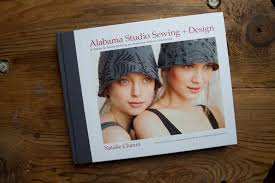 Natalie Chanin began the company Alabama Chanin in 2000, in her hometown of Florence, Alabama. Her original garments were handsewn by local workers, and offered a high-priced but ethically-and American-made womenswear line that allowed her to work exclusively with high-quality organic materials, forward-looking embellishment techniques, as well as bring jobs to a depressed economy she’d grown up in. Gradually she added products for the home, and DIY products that are cut out in their factory, but assembled at home by the purchaser. From there, it’s a small step indeed to this how-to which includes patterns for her signature silhouettes and detailed information on how to create her favorite types of embellishments.
Natalie Chanin began the company Alabama Chanin in 2000, in her hometown of Florence, Alabama. Her original garments were handsewn by local workers, and offered a high-priced but ethically-and American-made womenswear line that allowed her to work exclusively with high-quality organic materials, forward-looking embellishment techniques, as well as bring jobs to a depressed economy she’d grown up in. Gradually she added products for the home, and DIY products that are cut out in their factory, but assembled at home by the purchaser. From there, it’s a small step indeed to this how-to which includes patterns for her signature silhouettes and detailed information on how to create her favorite types of embellishments.
http://www.alabamachanin.com/about-alabama-chanin
Her clothing is simple, but made-to-order, and includes elaborate embroidery, applique, and beaded details. It’s sort of Eileen Fisher ++, very understated and comfortable, but still funky and elegant. We thought the techniques demonstrated here were new and different and inspiring. Once I found out more about Chanin’s company, I am only more inspired. And I want everything she makes.
Alabama Studio Style, by Natalie Chanin
5th Floor Main Stacks TT157 .C367
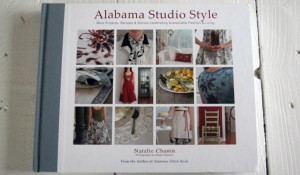 FIT’s concerns expanding, of course, to housewares and interior design, we also have the Alabama Chanin style book depicting the general studio and marketing stylebook. Come take a peek!
FIT’s concerns expanding, of course, to housewares and interior design, we also have the Alabama Chanin style book depicting the general studio and marketing stylebook. Come take a peek!
This has been another issue of Needles in the Stacks, by Beth McMahon and Denise Ingram. We hope to see you in the FIT Library soon!
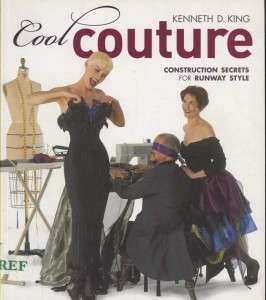

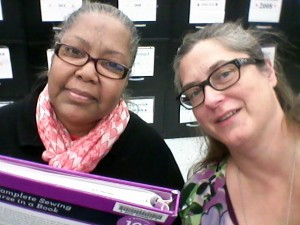
Comments
11 responses to “Needles in the Stacks: Couture edition”
[…] http://blog.fitnyc.edu/volumesandissues/2014/03/21/needles-in-the-stacks-couture-edition/ ) […]
Thank you for sharing the information. I am looking for information about sewing machines and books for beginners.
To elect right sewing mechine for begginers is much difficult. I saw here a list of sewing machines prefect for a beginners. Hope it will help you to sort out the correct one.
All the best
This is the internet age, everyone can find and read anything online but having a book on hand is really good, I’m very please to see your article, I will buy “The Dressmaker’s Technique Bible, by Lorna Knight”. It will be helpful for my blog.
I am looking for information about sewing machines and books for beginners. Thanks for your sharing!
Happy New Year!
Books for beginners, eh. I would recommend several of them I mentioned in the first post of reviews: http://blog.fitnyc.edu/volumesandissues/2013/10/04/sewing-for-fun-and-profit/. In particular, the Reader’s Digest Guide is my personal sentimental favorite reference, but I also thought the Sewing 101 was good. One of the other answers to this post also recommended videos from our friend, the internet. I’m sure there are millions of videos that might help. Good luck to you!
[…] very much the sort of thing that makes a garment special and interesting, a la the Alabama Studio, whose books we reviewed back in […]
[…] very much the sort of thing that makes a garment special and interesting, a la the Alabama Studio, whose books we reviewed back in […]
[…] the Week for both this week and last. Since this title, Vogue Patterns, is related to our popular Needles in the Stacks series, I wanted to do some meaty research on the review. That should be out tomorrow or the next […]
Those are the concerning values and the prospects been mentioned in detail and favorably for the future would further allow students to go through with all those provisions as prescribed.
This is so great! I’m going to learn to sew this year. Thanks for such a helpful roundup!